
How To Use The Skyscraper Technique To Land SEO Backlinks To Your Website
How To Use The Skyscraper Technique To Land SEO Backlinks To Your Website
The skyscraper technique is one of the most scalable ways to get free backlinks to your website.
And in this tutorial, I’ll teach you exactly how I land thousands of backlinks using this method.
You’ll learn:
- How the skyscraper technique works
- Why this link building technique is so powerful
- The actionable steps to start landing backlinks to your website right now
- Easy, quick hacks to optimize your link building results with outreach
What Is The Skyscraper Technique?
The skyscraper technique is a way of using content marketing to get backlinks to your website.
Here’s how it works in 4 simple steps:
1: Research: Find ‘link worthy’ topics to write about by reverse engineering your competitor’s content.
2: Prospect: Create a prospect list of websites that have linked to your competitor’s content.
3: Content: Produce an all-around better article VS your competitor.
4: Outreach: Reach out to the prospects from step 2 via cold email, building backlinks as a result.
Basically you’ll publish 1 piece of content on your blog:
And then build backlinks straight to that page from other websites.
In this guide, I’ll reveal how to do all of the above – and build backlinks along the way…
Why Is The Skyscraper Technique So Powerful For SEO?
This is a tried, tested and proven way to get backlinks to your website for free.
Plus, it’s very scalable.
With the tools I’ll show you in this guide, you’ll be able to automate the whole process.
But does it really work?
And in an age where most websites ask for money, can you really get free backlinks?
Well, in terms of results, here’s 1 website I took from zero to almost 1,500 visitors per day in just 1 year:
And the only links I built to this website were with the skyscraper technique.
Step 1: Research
Picking the right topic for your skyscraper content is critical.
Get this wrong, and the whole process is doomed to failure.
So how can you find the best skyscraper article for your website?
The best way I’ve found is to reverse engineer your competitors content, see what works for them and then emulate it – just like this:
How To Prospect With Ahrefs
Go to Ahrefs.com > Content Explorer:

Then type in a keyword relevant to your niche…
Let’s say you’re in the dogs niche – you’d type in a relevant keyword like “Dogs” and select ‘In Title’ from the drop down box:
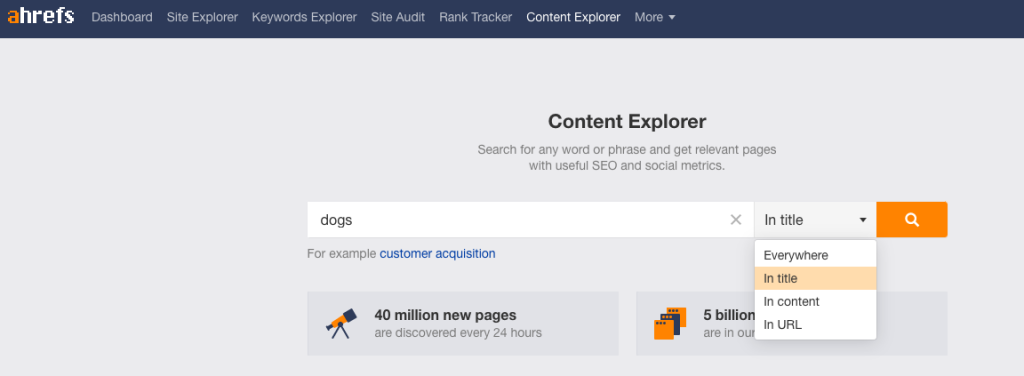
Then scroll down and sort the results by ‘Referring Domains’ (because you want to find the content that’s attracting the most links):
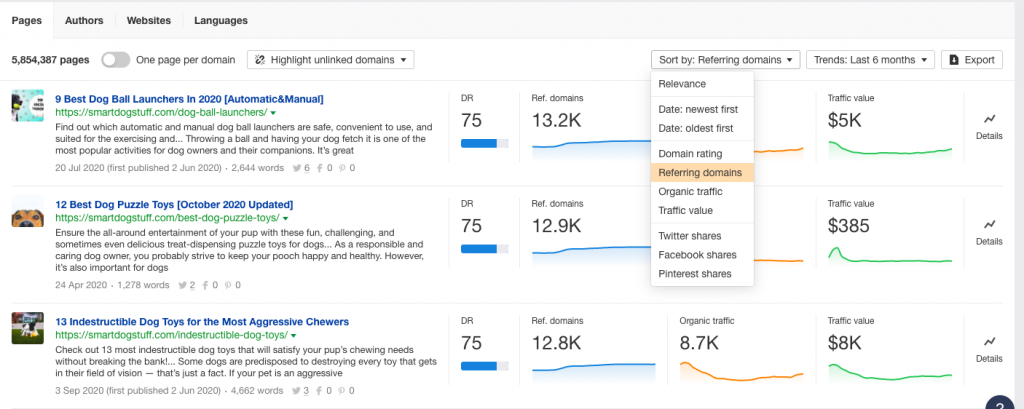
From here, you can scroll through the list and find a bunch of topic ideas that you can create your skyscraper content around.

Put your ideas into a spreadsheet, noting:
- Article Topic
- Referring Domains Per Topic
- Whether you already have a similar article published or if it’s new
Here’s the golden rule for skyscraper content:
Never use content that’s commercially driven.
Remember:
You’ll be reaching out to other websites, promoting your content and asking them to add a link to your site.
So if your content is too self promotional, they’re not going to link to you.
Why?
Because they know you’re making money from your content.
So the best question to ask yourself is:
“What topics would a webmaster realistically link to?” and use common sense here.
E.g. Best dog food products to buy isn’t a good title – it’s promoting products and could be laced with affiliate links/easily monetised.
How to make your own dog food could be a much better title – because this doesn’t promote any products and is very value driven for the reader.
The more value there is for the reader, the more likely the webmaster is going to add a link to your content.
Another hack:
Look at whether you can realistically beat your competitors content.
You want your article to obviously be better than your competitor’s.
(Sometimes the website will swap your competitor’s link out for yours if it’s good enough.)
So pick your battles here:
If you can’t produce a better article VS your competitors, move on to the next opportunity. This will save you a lot of time in the long run.
Plus, never skip this research phase:
This will make or break your campaign!
Get this right and you’ll lay the foundation for a skyscraper campaign that lands you backlinks for months to come…
Step 2: Prospecting
Now it’s time to prospect.
So here you’ll create a list of websites/email addresses you can reach out to via cold email.
What’s the best way to do this?
Look at everyone who linked to your competitors content in step 1.
You can easily get a list of these sites using Ahrefs.
How to prospect with Ahrefs:
Go to Ahrefs > Type the competing URL into their Site Explorer:
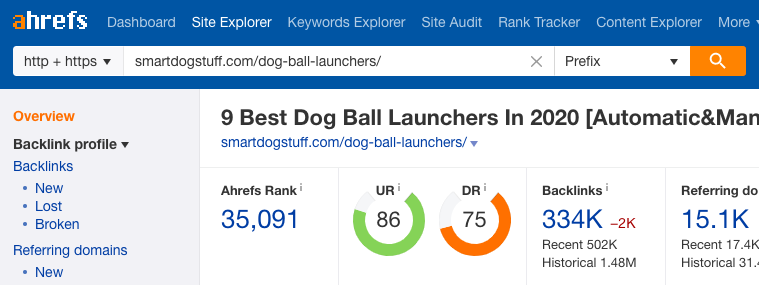
Go to ‘Backlinks’ > Filter ‘Link Type’ to ‘Dofollow’ (you don’t want to reach out to websites for nofollow links):
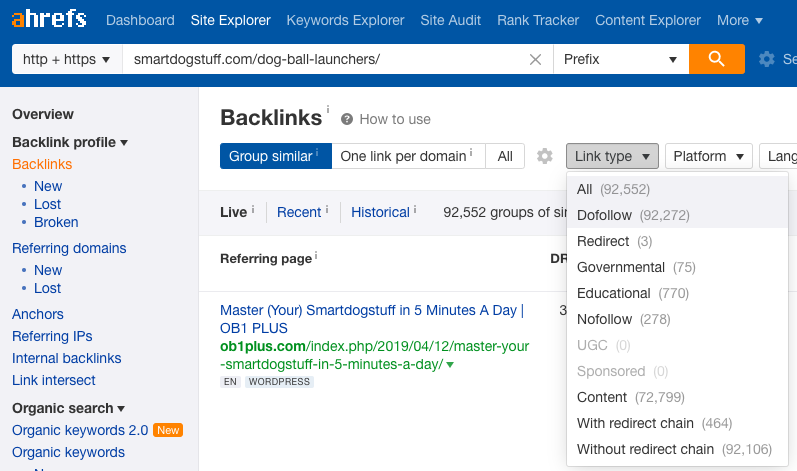
Go to Export > ‘Microsoft Excel’ > Open it up in Google Sheets:
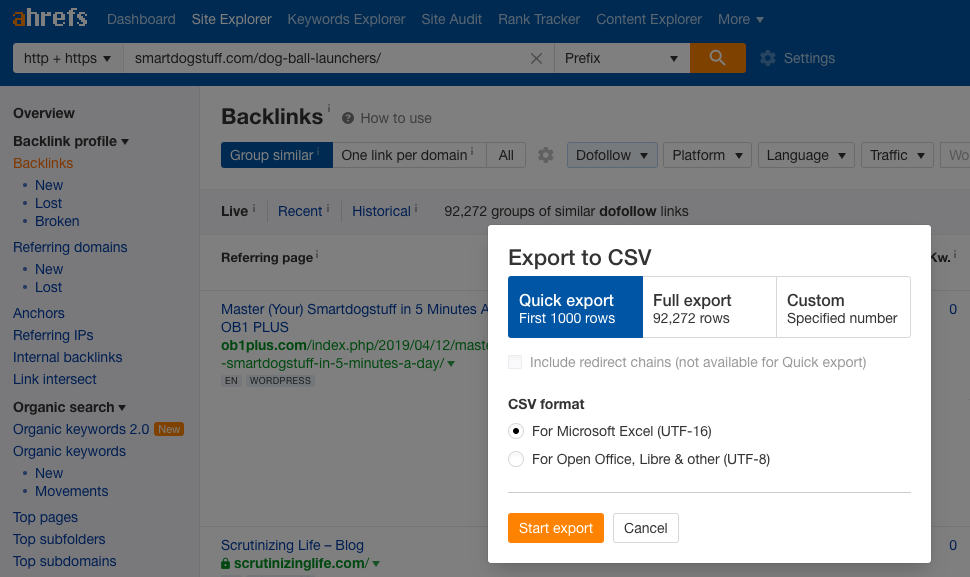
Now you’ll have a raw list of all the potential sites you could reach out to.
But not all backlinks are equal – and there’s likely to be a lot of spam on the list.
So how can you filter them out?
You can use these metrics to help you filter out the ideal sites:
- Ahrefs Domain Rating: This is an estimate of a site’s overall authority. The higher it is, the more authoritative a website may be
- Organic traffic: Go for sites that are getting a decent amount of traffic from Google. 100+ visitors per month is a good sign.
- Penalties: If the website has received a Google Penalty in the past and there’s a huge dip in their organic traffic, that’s a link you should try to avoid
- Relevance: Is the website contextually relevant to you? Will the link look natural if they add it to their article?
- Quality: What’s the overall quality of the site like? Does it look like a real website people would actually read? Or does it look very spammy/low quality?
You don’t have to be too strict on the above factors – it’s better to use common sense here.
But if a website has a lot of red flags, filter it out.
It’s better to do this early in the process, to save yourself time.
Here’s a quick video tutorial on exactly how to run through your list and filter out the right prospects:
Once your list of URLs is ready, it’s time to find the email address for each person.
How? You could:
- Search the website manually – especially the contact/about us pages
- Check the website owner’s LinkedIn page for an email address
- Or what I usually do, is run the site through Hunter to bulk search emails
But a word of warning:
Many email addresses you’ll find online don’t work – sometimes almost as many as 50% aren’t valid!
Why?
Staff move on, people set up spam trap email addresses or sometimes it’s just a typo.
Whatever the issue, make sure you verify your email addresses before sending them.
This will avoid high bounce rates, improving your deliverability and landing you more backlinks in the long run.
Tools like Neverbounce and Clearout are useful for this.
Step 3: Content Creation
Your content is the linkable asset:
If it sucks, no-one will link to it.
So you have to get this right:
Luckily there’s a few optimizations you can make to boost your conversions with cold email outreach.
Here’s what I’d recommend:
- Look at your competitor’s content VS yours: How can you beat it? Can you be more detailed? More up to date? Better design?
- Don’t include commercial elements: No opt-ins, pop-ups, affiliate links – I could list 100 different ways you SHOULDN’T monetize your content here! Basically, your content should just be 100% value driven.
- Unique Angle: Tackle your competitor’s article from a fresh perspective. This makes you stand out and gives the webmaster a reason to link to you
- References: Sprinkle plenty of references and useful resources across your page to make it look well researched
And one of the BIGGEST mistakes I see most link builders make is picking the wrong content to promote.
Avoid pages that have any sort of commercial intent:
Sales pages. Product pages. Lead magnets.
These are all no-gos that you should avoid.
Instead just focus on promoting informational, value driven content (you can always monetize them later after the links have been built).
Overall, better content = more links.
Step 4: Email Outreach
Now it’s finally time to start reaching out to websites via cold email.
When you’re writing your email copy, there’s a lot of ways to get this wrong.
So how can you write the perfect outreach email?
- Keep it short and straight to the point
- Don’t include words that’ll trigger spam filters e.g. free
- Add personalization e.g. you could mention their name, a recent article they’ve published etc
- Add a few puns/jokes to keep it light hearted and build rapport
- Make it easy to scan/read through
Here’s an example of an outreach email that delivered thousands of backlinks:
Plus, make sure you follow up:
I usually send 1-2 follow ups on an email campaign.
Why?
Because it’s easy for someone to ignore your first email.
They might be busy, distracted or overloaded with work! So send a couple of follow-ups to ensure you’re not forgotten about.
Now there’s also a few hacks you can use to improve your email deliverability.:
Higher deliverability = more backlinks.
And if you’re sending cold emails at scale, you can quickly get marked as spam if you haven’t set up the sending email address properly.
So how do you improve your email deliverability?
- Setup DMARC
- Use DKIM
- If you’re using a new email address, gradually warm up your account by sending 5-10 emails per day at first
- Don’t send all your emails at once – that’s an easy way for your email account to get blocked
Plus, send cold emails from a separate URL to your main domain:
E.g. if your site is example.com use example.io
Why?
Because sending a lot of cold emails long term will reduce your site’s overall email deliverability.
So use a separate URL instead, that you don’t mind burning out.
You can also automate your cold emails.
Doing this will save you time – just be careful to do this in moderation.
You can use tools like Mailshake or Lemlist to automate your emails – just like this:
The views included in this article are entirely the work and thoughts of the author, and may not always reflect the views and opinions of Regex SEO.

